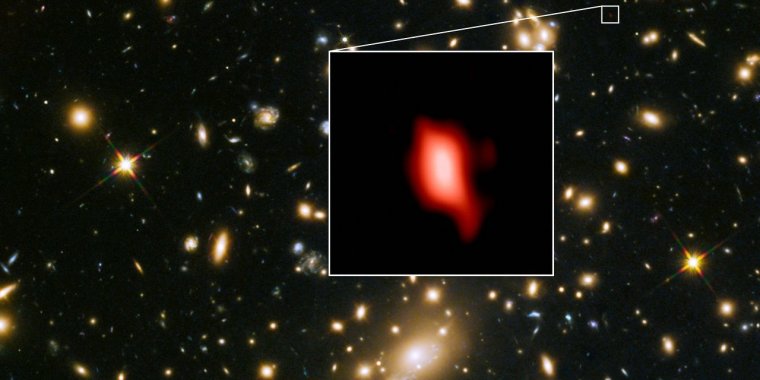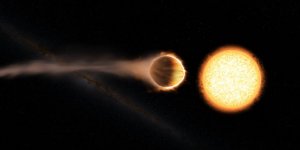| News / Space News |
ALMA and VLT Find Evidence for Stars Forming Just 250 Million Years After Big Bang
Astronomers have used observations from the Atacama Large Millimeter/submillimeter Array (ALMA) and ESO’s Very Large Telescope (VLT) to determine that star formation in the very distant galaxy MACS1149-JD1 started at an unexpectedly early stage, only 250 million years after the Big Bang. This discovery also represents the most distant oxygen ever detected in the Universe and the most distant galaxy ever observed by ALMA or the VLT.

Hubble and ALMA image of MACS J1149.5+2223. ![]()
An international team of astronomers detected a very faint glow emitted by ionised oxygen in the galaxy. As this infrared light travelled across space, the expansion of the Universe stretched it to wavelengths more than ten times longer by the time it reached Earth and was detected by ALMA.
The team inferred that the signal was emitted 13.3 billion years ago (or 500 million years after the Big Bang), making it the most distant oxygen ever detected by any telescope. The presence of oxygen is a clear sign that there must have been even earlier generations of stars in this galaxy.
A weaker signal of hydrogen emission was also detected. The distance to the galaxy determined from this observation is consistent with the distance from the oxygen observation.
This makes MACS1149-JD1 the most distant galaxy with a precise distance measurement and the most distant galaxy ever observed with ALMA or the VLT.
For a period after the Big Bang there was no oxygen in the Universe; it was created by the fusion processes of the first stars and then released when these stars died.
The detection of oxygen in MACS1149-JD1 indicates that these earlier generations of stars had been already formed and expelled oxygen by just 500 million years after the beginning of the Universe.
The team found that the observed brightness of the galaxy is well-explained by a model where the onset of star formation corresponds to only 250 million years after the Universe began.
The maturity of the stars seen in MACS1149-JD1 raises the question of when the very first galaxies emerged from total darkness, an epoch astronomers romantically term “cosmic dawn”. (ESO)
YOU MAY ALSO LIKE


